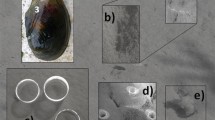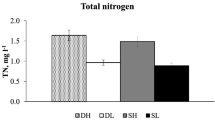Abstract
The effect of the bivalveCorbicula japonica on the nitrogen cycle in Lake Shinji, a mesohaline brackish lagoon in Japan, was examined quantitatively based on field surveys and laboratory experiments carried out in the summer of 1982 and 1983. The biomass of the flesh ofC. japonica comprised 97% of the total biomass of the macrozoobenthos in summer. Total biomass ofC. japonica in the lake was estimated 30 986 t fresh wt. The concentration of suspended solids immediately above the lake bottom, whereC. japonica filters the water, was 1.5 to 4 times higher than that in the surface water. In laboratory experiments, the filtration rate was 5.0 litres g dry flesh wt-1 h-1, the excretion rates of ammonia and of feces and pseudofeces ofC. japonica were 200×10-6 g N g dry flesh wt-1 h-1 and 33.4 mg dry wt g dry flesh wt-1 h-1, respectively at 27°C, the average summer water temperature in the lake. From our study, we estimated thatC. japonica filters almost the same amounts of particulate organic nitrogen produced in the lake by phytoplankton and that supplied from rivers, and that it excretes 30% of filtered nitrogen as feces or pseudofeces and 18% as ammonia.
Similar content being viewed by others
Literature cited
Bayne, B. L., Thompson, R. J. and Widdows, J. (1976). Physiology: I In: Bayne, B. L. (ed.) Marine mussels: their ecology and physiology. Cambridge University Press, London, p. 121–206
Horwitz, W. (ed.) (1980). 24. Meat and meat products. In: Official methods of analysis of the Association of Official Analytical Chemists. 13th edn, Association of Official Analytical Chemists, Inc., Washington DC. p. 376–384
Jordan, T. E., Valiela, I. (1982). A nitrogen budget of the ribbed mussel,Geukensia demissa, and its significance in nitrogen flow in a New England salt marsh. Limnol. Oceanogr. 27: 75–90
Kawakami, S. (1982). Water quality and input of pollutant at Lake Shinji. In: Symposium committee of West Japan Branch of Agricultural Chemical Society of Japan (ed.) Proceedings of the symposium of “Problems on dynamics in water environment”. Symposium committee of West Japan Branch of Agricultural Chemical Society of Japan, Shimane, p. 1–44
Kawatsu, M., Kamiya, H., Ishitobi, H., Yasuda, Y., Hayashi, K. (1984). Mineralization of nutrient salt in the lake sediment (2). Rep. Shimane prefect. Inst. of publ. Health and environ. Sci. 26: 34–41
Morimoto N., Kawakami, S., Ishihara, J., Kuzuhara, M. (1977). Pollution and phytoplankton at Lake Shinji. J. Water and Waste 19: 407–419
Ochiai, H., Sugai, R. (1981). Runoff of pollutant at River Hii at the event of flood. J. Water and Waste 23: 1317–1323
Prosch, R. M., McLachlan, A. (1984). The regeneration of surfzone nutrients by the sand mussel,Donax serra Röding. J. exp. mar. Biol. Ecol. 80: 221–233
Rhoads, D. C., Aller, R. C., Goldhaber, M. B. (1977). The influence of colonizing benthos on physical properties and chemical diagenesis of the estuarine seafloor. In: Coull, B. C. (ed.) Ecology of marine benthos. University of South Carolina Press, Columbia, South Carolina, p. 113–138
Short, F. T., Short, C. A. (1984). The seagrass filter: Purification of estuarine and coastal waters. In: Kennedy, V. S. (ed.) The estuary as a filter. Academic Press, Florida, p. 395–413
Strickland, J. D. H., Parsons, T. R. (1972). A practical handbook of seawater analysis. Bull. Fish. Res. Bd Can. 167: 1–310
Tátrai, I. (1986). Rates of ammonia release from sediments by chironomid larvae. Freshwater Biol. 16: 61–66
Walne, R. P. (1972). The influence of current speed, body size and water temperature on the filtration rate of five species of bivalves. J. mar. biol. Ass. U.K. 52: 345–374
Author information
Authors and Affiliations
Additional information
Communicated by M. Anraku, Tokyo
Rights and permissions
About this article
Cite this article
Nakamura, M., Yamamuro, M., Ishikawa, M. et al. Role of the bivalveCorbicula japonica in the nitrogen cycle in a mesohaline lagoon. Mar. Biol. 99, 369–374 (1988). https://doi.org/10.1007/BF02112129
Accepted:
Issue Date:
DOI: https://doi.org/10.1007/BF02112129




